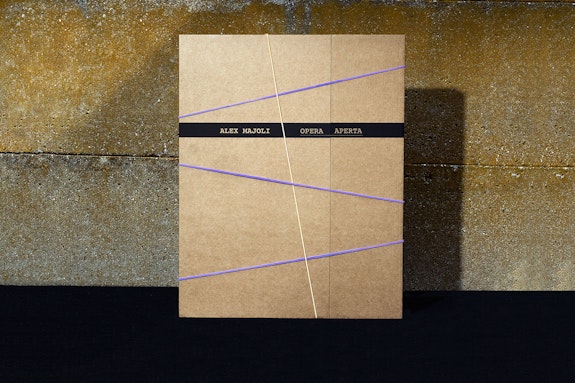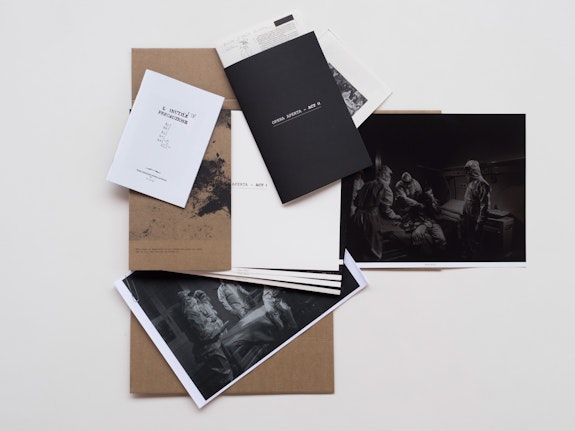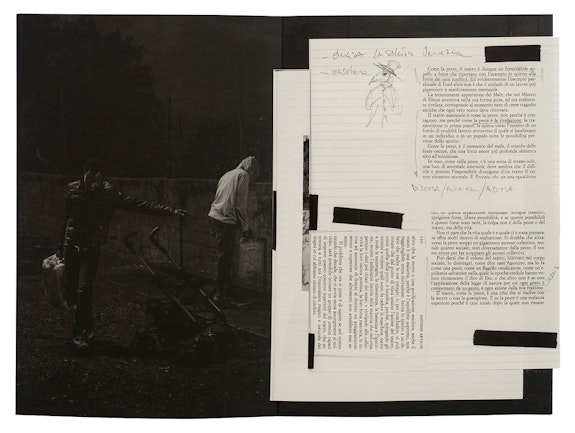Art Books
Alex Majoli’s Opera Aperta
This composite project incorporates ideas about performance and the pandemic in a narrative that cannily straddles realism and symbolic exaggeration.

Alex Majoli
(CESURA, 2021)
Whether covering quotidian moments or circumstances of humanitarian urgency, Alex Majoli—a longtime photojournalist and member of the Magnum Photos collective—has an aesthetic signature: using powerful artificial lighting while on location. This creates steep graphic contrasts that imbue his images with an epic feel despite being anchored in realism.
Majoli’s penultimate project to date, Scene, was a 2019 publication and exhibition (by MACK Books and at Le Bal in Paris, respectively) that gathered photographic images taken over eight years across Europe, Asia, Brazil, and Congo. In Majoli’s new work, Opera Aperta—a composite project commissioned by the Fondazione I Teatri in Reggio Emilia—he incorporates ideas about performance and the pandemic in a narrative that cannily straddles realism and symbolic exaggeration. Majoli has acknowledged that, even as a photojournalist covering “real” events, performativity factors into his work. There is a propensity, among photojournalists and picture editors alike, to select images with intensified facial and body language as a device for magnifying sociopolitical situations. Majoli highlights that reportages still contain subjectivity, making storytelling tricky to differentiate from non-fiction. This ambiguity reflects the status quo of our epoch: incredulity about the facts, showmanship in lieu of verity, and whiplash-rapid evolutions as to how to frame the information we’ve received.

Opera Aperta, translated as “Open Work,” namechecks the performance troupe that Majoli features in the book. It is also the name of a 1962 book of essays by Umberto Eco, in which he argues for an open-ended approach to narrative—a concept Majoli’s unconventional portfolio of unbound images honors, thematically and formally. Opera Aperta has multiple components at different scales, functioning like a trove of documents rather than a traditional, tidily-arranged tome, the sundry elements of which are all packaged in a cardboard envelope. The unwieldy format necessitates conceptual engagement and plenty of elbowroom, as its deconstructed design, dreamed up by Silvia Castagnoli, makes it fragile and unorthodox to handle and navigate. It unfurls asymmetrically: part archive to decipher, part labyrinthine paper sculpture experienced like origami in reverse.
Opera Aperta started when Majoli began working with two Italian actors, photographing them as they improvised amidst the urban panorama. When COVID-19 disrupted the project, Majoli pivoted to chronicle his ravaged native Italy. The actors Majoli collaborated with eventually began rehearsing The Barber of Seville to stream the production online. Performance was no longer just a symbol but a literal framework, as Majoli photographed figures onstage and off.

In deference to the theater theme, Majoli structured the work into three acts (which are labeled as such, and physically distinct), in addition to separate zine-like publications interspersing visuals and texts (like academic writing on avant-garde French dramatist Antonin Artaud). “Act I” gathers oversized horizontal black-and-white images (in a tonality that critic David Campany has described as seemingly set “at the sunless end of the day”): shadowy figures in alleyways, in staid interiors, on slabs of rock. Each image is discreetly marked with a “#Scene” number at the bottom, in seemingly no chronology. “Act II” takes the form of a magazine-like publication on matte paper, easy to leaf through and with a more continuous character study. In “Act III,” the oversized horizontal format of “Act I” returns, with an ensemble of images in which Majoli stages a scene of a bedridden patient thronged by doctors in protective gear—a dystopic trope turned 21st-century pandemic standard. (Although here, the patients don stage costumes.) “Act III” concludes with text from St. Augustine Confessions, Book Three (Le Confessioni di Sant’Agostino, Libro terzo). The theologian wonders: “Why is it that a person should wish to experience suffering by watching grievous and tragic events which he himself would not wish to endure?” It’s a musing about the role of the witness, paralleling in turn the role of the photojournalist—and any viewer of the photojournalists’s work. Why are we surveying—and even sometimes willfully pursuing—sadness beyond the scope of our own?
Amidst all the folds of Opera Aperta is a single loose leaflet, a xerox of pages from Bertolt Brecht’s Poems of the Crisis Years, 1929–1933. These lines seem to have a partial reply to the above question: “pay a visit some time / To that theatre whose setting is the street. / The everyday, thousandfold, fameless / But vivid.” This appears to be Majoli’s modus operandi: providing visibility to “fameless” subjects, and making their realities as “vivid” as anyone else’s. He imbues these scenes with grandeur, enticing the viewer to take a more considered look at circumstances that are hard to face.

